*NURSING > TEST BANK > FULL - Elaborated Test Bank for Introduction to Critical Care Nursing 8Ed. by Mary Lou Sole, Deborah (All)
FULL - Elaborated Test Bank for Introduction to Critical Care Nursing 8Ed. by Mary Lou Sole, Deborah Klein & Marthe Moseley
Document Content and Description Below
FULL - Elaborated Test Bank for Introduction to Critical Care Nursing 8Ed. by Mary Lou Sole, Deborah Klein & Marthe Moseley ALL 21 Chapters included. PART I. Fundamental Concepts 1. Overview of cri... tical care nursing Definition of critical care nursing Evolution of critical care Professional organizations Certification Standards Critical care nurse characteristics Quality and safety emphasis Evidence-based practice Healthy work environment Collaborative plan of care for the critically ill patient Trends and issues in care delivery Issues related to the critical care nurse References 2. Patient and family response to the critical care experience Introduction The critical care environment The critically ill patient Family members of the critically ill patient References 3. Ethical and legal issues in critical care nursing Introduction Ethical obligations and nurse advocacy Ethical decision making Ethical principles Increasing nurses’ involvement in ethical decision making Selected ethical topics in critical care References 4. Palliative and end-of-life care Introduction Dimensions of end-of-life care Culturally competent end-of-life care Summary References 5. Organ donation Introduction Organ donation Types of organ donation Care of the family Evaluation of the potential organ donor Donor management Transplant candidate evaluation References 6. Comfort and sedation Introduction Definitions of pain and anxiety Predisposing factors to pain and anxiety Physiology of pain and anxiety Positive effects of pain and anxiety Negative effects of pain and anxiety Preventing and treating pain and anxiety Management of pain and anxiety Management challenges References PART II. Tools for the Critical Care Nurse 7. Nutritional therapy Introduction Anatomy and physiology of the alimentary tract Assessment Overview of nutritional therapy References 8. Dysrhythmia interpretation and management Introduction Overview of electrocardiogram monitoring Cardiac physiology review The 12-lead electrocardiogram Basics of dysrhythmia analysis Causes of dysrhythmias Dysrhythmia analysis Basic dysrhythmias Cardiac pacemakers Other devices with pacemaker capabilities References 9. Hemodynamic monitoring Introduction Review of anatomy and physiology Hemodynamic monitoring modalities Stroke volume optimization References 10. Ventilatory assistance Introduction Review of respiratory anatomy and physiology Physiology of breathing Lung volumes and capacities Respiratory assessment Oxygen administration Airway management Mechanical ventilation Nursing care Weaning patients from mechanical ventilation References 11. Rapid response teams and code management Introduction Rapid response teams Roles of caregivers in code management Equipment used in codes Resuscitation efforts Pharmacological intervention during a code Documentation of code events Care of the patient after resuscitation References PART III. Nursing Care During Critical Illness 12. Shock, sepsis, and multiple organ dysfunction syndrome Introduction Review of anatomy and physiology Assessment Management Classifications of shock Multiple organ dysfunction syndrome References 13. Cardiovascular alterations Introduction Normal structure and function of the heart Coronary artery disease Angina Acute coronary syndrome Interventional cardiology Mechanical therapies Cardiac dysrhythmias Heart failure Pericarditis Valvular heart disease Endocarditis Vascular alterations References 14. Nervous system alterations Introduction Anatomy and physiology of the nervous system Functional and structural divisions of the central nervous system Increased intracranial pressure Traumatic brain injury Acute stroke Seizures and status epilepticus Central nervous system infections Spinal cord injury References 15. Acute respiratory failure Introduction Acute respiratory failure Respiratory failure in acute respiratory distress syndrome Acute respiratory failure in chronic obstructive pulmonary disease Acute respiratory failure in asthma Acute respiratory failure resulting from pneumonia Ventilator-associated pneumonia and events Acute respiratory failure resulting from pulmonary embolism Acute respiratory failure in adult patients with cystic fibrosis References 16. Acute kidney injury Introduction Review of anatomy and physiology Pathophysiology of acute kidney injury Assessment Diagnostic procedures Patient problems Nursing interventions Medical management of acute kidney injury References 17. Hematological and immune disorders Introduction Review of anatomy and physiology Focused assessment of hematological and immunological function Selected erythrocyte disorders White blood cell and immune disorders Selected immunological disorders Bleeding disorders References 18. Gastrointestinal alterations Introduction Review of anatomy and physiology General assessment of the gastrointestinal system Acute gastrointestinal bleeding Acute pancreatitis Hepatic failure References 19. Endocrine alterations Introduction Hyperglycemia in the critically ill patient Pancreatic endocrine emergencies Acute and relative adrenal insufficiency Thyroid gland in critical care Thyroid crises Antidiuretic hormone disorders References 20. Trauma and surgical management Introduction Systems approach to trauma care Mechanisms of injury Emergency care phase: Triage Emergency care phase: Resuscitation Assessment and management of specific injuries Critical care phase Special considerations and populations Rehabilitation phase References 21. Burns Introduction Review of anatomy and physiology of the skin Mechanisms and etiology of injury Burn classification and severity Physiological responses to burn injury Phases of burn care assessment and collaborative interventions Special considerations and areas of concern Pain control Infection prevention Wound management Nutritional considerations Psychosocial considerations Lifespan considerations Nonburn injuries Discharge planning Burn preventionFULL - Elaborated Test Bank for Introduction to Critical Care Nursing 8Ed. by Mary Lou Sole, Deborah Klein & Marthe Moseley ALL 21 Chapters included. PART I. Fundamental Concepts 1. Overview of critical care nursing Definition of critical care nursing Evolution of critical care Professional organizations Certification Standards Critical care nurse characteristics Quality and safety emphasis Evidence-based practice Healthy work environment Collaborative plan of care for the critically ill patient Trends and issues in care delivery Issues related to the critical care nurse References 2. Patient and family response to the critical care experience Introduction The critical care environment The critically ill patient Family members of the critically ill patient References 3. Ethical and legal issues in critical care nursing Introduction Ethical obligations and nurse advocacy Ethical decision making Ethical principles Increasing nurses’ involvement in ethical decision making Selected ethical topics in critical care References 4. Palliative and end-of-life care Introduction Dimensions of end-of-life care Culturally competent end-of-life care Summary References 5. Organ donation Introduction Organ donation Types of organ donation Care of the family Evaluation of the potential organ donor Donor management Transplant candidate evaluation References 6. Comfort and sedation Introduction Definitions of pain and anxiety Predisposing factors to pain and anxiety Physiology of pain and anxiety Positive effects of pain and anxiety Negative effects of pain and anxiety Preventing and treating pain and anxiety Management of pain and anxiety Management challenges References PART II. Tools for the Critical Care Nurse 7. Nutritional therapy Introduction Anatomy and physiology of the alimentary tract Assessment Overview of nutritional therapy References 8. Dysrhythmia interpretation and management Introduction Overview of electrocardiogram monitoring Cardiac physiology review The 12-lead electrocardiogram Basics of dysrhythmia analysis Causes of dysrhythmias Dysrhythmia analysis Basic dysrhythmias Cardiac pacemakers Other devices with pacemaker capabilities References 9. Hemodynamic monitoring Introduction Review of anatomy and physiology Hemodynamic monitoring modalities Stroke volume optimization References 10. Ventilatory assistance Introduction Review of respiratory anatomy and physiology Physiology of breathing Lung volumes and capacities Respiratory assessment Oxygen administration Airway management Mechanical ventilation Nursing care Weaning patients from mechanical ventilation References 11. Rapid response teams and code management Introduction Rapid response teams Roles of caregivers in code management Equipment used in codes Resuscitation efforts Pharmacological intervention during a code Documentation of code events Care of the patient after resuscitation References PART III. Nursing Care During Critical Illness 12. Shock, sepsis, and multiple organ dysfunction syndrome Introduction Review of anatomy and physiology Assessment Management Classifications of shock Multiple organ dysfunction syndrome References 13. Cardiovascular alterations Introduction Normal structure and function of the heart Coronary artery disease Angina Acute coronary syndrome Interventional cardiology Mechanical therapies Cardiac dysrhythmias Heart failure Pericarditis Valvular heart disease Endocarditis Vascular alterations References 14. Nervous system alterations Introduction Anatomy and physiology of the nervous system Functional and structural divisions of the central nervous system Increased intracranial pressure Traumatic brain injury Acute stroke Seizures and status epilepticus Central nervous system infections Spinal cord injury References 15. Acute respiratory failure Introduction Acute respiratory failure Respiratory failure in acute respiratory distress syndrome Acute respiratory failure in chronic obstructive pulmonary disease Acute respiratory failure in asthma Acute respiratory failure resulting from pneumonia Ventilator-associated pneumonia and events Acute respiratory failure resulting from pulmonary embolism Acute respiratory failure in adult patients with cystic fibrosis References 16. Acute kidney injury Introduction Review of anatomy and physiology Pathophysiology of acute kidney injury Assessment Diagnostic procedures Patient problems Nursing interventions Medical management of acute kidney injury References 17. Hematological and immune disorders Introduction Review of anatomy and physiology Focused assessment of hematological and immunological function Selected erythrocyte disorders White blood cell and immune disorders Selected immunological disorders Bleeding disorders References 18. Gastrointestinal alterations Introduction Review of anatomy and physiology General assessment of the gastrointestinal system Acute gastrointestinal bleeding Acute pancreatitis Hepatic failure References 19. Endocrine alterations Introduction Hyperglycemia in the critically ill patient Pancreatic endocrine emergencies Acute and relative adrenal insufficiency Thyroid gland in critical care Thyroid crises Antidiuretic hormone disorders References 20. Trauma and surgical management Introduction Systems approach to trauma care Mechanisms of injury Emergency care phase: Triage Emergency care phase: Resuscitation Assessment and management of specific injuries Critical care phase Special considerations and populations Rehabilitation phase References 21. Burns Introduction Review of anatomy and physiology of the skin Mechanisms and etiology of injury Burn classification and severity Physiological responses to burn injury Phases of burn care assessment and collaborative interventions Special considerations and areas of concern Pain control Infection prevention Wound management Nutritional considerations Psychosocial considerations Lifespan considerations Nonburn injuries Discharge planning Burn prevention Chapter 01: Overview of Critical Care Nursing Sole: Introduction to Critical Care Nursing, 7th Edition MULTIPLE CHOICE 1. Which of the following professional organizations best supports critical care nursing practice? a. American Association of Critical-Care Nurses b. American Heart Association c. American Nurses Association d. Society of Critical Care Medicine ANS: A The American Association of Critical-Care Nurses is the specialty organization that supports and represents critical care nurses. The American Heart Association supports cardiovascular initiatives. The American Nurses Association supports all nurses. The Society of Critical Care Medicine represents the multiprofessional critical care team under the direction of an intensivist. DIF: Cognitive Level: Remember/Knowledge REF: p. 5 OBJ: Discuss the purposes and functions of the professional organizations that support critical care practice. TOP: Nursing Process Step: N/A MSC: NCLEX Client Needs Category: Safe and Effective Care Environment 2. A nurse has been working as a staff nurse in the surgical intensive care unit for 2 years and is interested in certification. Which credential would be most applicable for the nurse to seek? a. ACNPC-AG b. CNML c. CCRN d. PCCN ANS: C The CCRN certification is appropriate for nurses in bedside practice who care for critically ill patients. The ACNPC-AG certification is for acute care nurse practitioners. The CNML is for critical care nurse managers or leaders. The PCCN certification is for staff nurses working in progressive care, intermediate care, or step-down unit settings. DIF: Cognitive Level: Remember/Knowledge REF: p. 6 OBJ: Explain certification options for critical care nurses. TOP: Nursing Process Step: N/A MSC: NCLEX Client Needs Category: Safe and Effective Care Environment 3. The main purpose of certification is to a. assure the consumer that you will not make a mistake. b. prepare for graduate school. c. promote magnet status for your facility. d. validate knowledge of critical care nursing. ANS: D INTRODUCTION TO CRITICAL CARE NURSING 7TH EDITION SOLE TEST BANK NURSINGTB.COM Certification assists in validating knowledge of the field, promotes excellence in the profession, and helps nurses to maintain their knowledge of critical care nursing. Certification helps to assure the consumer that the nurse has a minimum level of knowledge; however, it does not ensure that care will be mistake-free. Certification does not prepare one for graduate school; however, achieving certification demonstrates motivation for achievement and professionalism. Magnet facilities are rated on the number of certified nurses; however, that is not the purpose of certification. DIF: Cognitive Level: Remember/Knowledge REF: p. 6 OBJ: Explain certification options for critical care nurses. TOP: Nursing Process Step: N/A MSC: NCLEX Client Needs Category: Safe and Effective Care Environment 4. The synergy model of practice focuses on a. allowing unrestricted visiting for the patient 24 hours a day. b. holistic and alternative therapies. c. the needs of patients and their families, which drive nursing competency. d. patients’ needs for energy and support. ANS: C The synergy model of practice states that the needs of patients and families influence and drive competencies of nurses. Nursing practice based on the synergy model would involve tailored visiting to meet the patient’s and family’s needs and the application of alternative therapies if desired by the patient, but that is not the primary focus of the model. DIF: Cognitive Level: Remember/Knowledge REF: p. 6 OBJ: Describe standards of professional practice for critical care nursing. TOP: Nursing Process Step: N/A MSC: NCLEX Client Needs Category: Safe and Effective Care Environment 5. The family of your critically ill patient tells you that they have not spoken with the physician in over 24 hours and that they have some questions they want clarified. During morning rounds, you convey this concern to the attending intensivist and arrange a meeting with the family at 4:00 PM. Which competency of critical care nursing does this represent? a. Advocacy and moral agency in solving ethical issues b. Clinical judgment and clinical reasoning skills c. Collaboration with patients, families, and team members d. Facilitation of learning for patients, families, and team members ANS: C Although one might consider that all of these competencies are being addressed, communication and collaboration with the family and physician best exemplify the competency of collaboration. DIF: Cognitive Level: Analyze/Analysis REF: p. 6 | Fig 1-3 | Box 1-1 OBJ: Describe standards of professional practice for critical care nursing. TOP: Nursing Process Step: N/A MSC: NCLEX Client Needs Category: Safe and Effective Care Environment 6. The AACN Standards for Acute and Critical Care Nursing Practice use what framework to guide critical care nursing practice? a. Evidence-based practice NURSINGTB.COM INTRODUCTION TO CRITICAL CARE NURSING 7TH EDITION SOLE TEST BANK b. Healthy work environment c. National Patient Safety Goals d. Nursing process ANS: D The AACN Standards for Acute and Critical Care Nursing Practice delineate the nursing process as applied to critically ill patients: collect data, determine diagnoses, identify expected outcomes, develop a plan of care, implement interventions, and evaluate care. AACN promotes a healthy work environment, but this is not included in its standards. The Joint Commission has established National Patient Safety Goals, but these are not the AACN standards. DIF: Cognitive Level: Remember/Knowledge REF: p. 6 OBJ: Describe standards of professional practice for critical care nursing. TOP: Nursing Process Step: N/A MSC: NCLEX Client Needs Category: Safe and Effective Care Environment 7. The charge nurse is responsible for making the patient assignments on the critical care unit. An experienced, certified nurse is assigned to care for the acutely ill patient with sepsis who also requires continuous renal replacement therapy and mechanical ventilation. The nurse with less than 1 year of experience is assigned to two patients who are more stable. This assignment reflects implementation of the a. crew resource management model. b. National Patient Safety Goals. c. Quality and Safety Education for Nurses (QSEN) model. d. synergy model of practice. ANS: D This assignment demonstrates nursing care to meet the needs of the patient. The synergy model notes that the nurse competencies are matched to the patient characteristics. Crew resource management concepts are related to team training; National Patient Safety Goals are specified by The Joint Commission to promote safe care but do not incorporate the synergy model. The Quality and Safety Education for Nurses initiative involves targeted education of undergraduate and graduate nursing students on quality and safety concepts. DIF: Cognitive Level: Analyze/Analysis REF: p. 6 OBJ: Describe standards of professional practice for critical care nursing. TOP: Nursing Process Step: N/A MSC: NCLEX Client Needs Category: Safe and Effective Care Environment 8. The vision of the American Association of Critical-Care Nurses is a health care system driven by a. a healthy work environment. b. care from a multiprofessional team under the direction of a critical care physician. c. the needs of critically ill patients and families. d. respectful, healing, and humane environments. ANS: C INTRODUCTION TO CRITICAL CARE NURSING 7TH EDITION SOLE TEST BANK NURSINGTB.COM The AACN vision is a health care system driven by the needs of critically ill patients and families where critical care nurses make their optimum contributions. AACN promotes initiatives to support a healthy work environment as well as respectful and healing environments, but that is not the organization’s vision. The Society of Critical Care Medicine (SCCM) promotes care from a multiprofessional team under the direction of a critical care physician. DIF: Cognitive Level: Remember/Knowledge REF: p. 5 OBJ: Discuss the purposes and functions of the professional organizations that support critical care practice. TOP: Nursing Process Step: N/A MSC: NCLEX Client Needs Category: Safe and Effective Care Environment 9. The most important outcome of effective communication is to a. demonstrate caring practices to family members. b. ensure that patient teaching is done. c. meet the diversity needs of patients. d. reduce patient errors. ANS: D Many errors are directly attributed to faulty communication. Effective communication has been identified as an essential strategy to reduce patient errors and resolve issues related to patient care delivery. Communication may demonstrate caring practices, address diversity needs, and be used for patient/family teaching; however, the main outcome of effective communication is patient safety. DIF: Cognitive Level: Remember/Knowledge REF: p. 9 OBJ: Describe quality and safety initiatives related to critical care nursing. TOP: Nursing Process Step: N/A MSC: NCLEX Client Needs Category: Safe and Effective Care Environment 10. You are caring for a critically ill patient whose urine output has been low for 2 consecutive hours. After a thorough patient assessment, you call the intensivist with report. Which information do you convey regarding background? a. Urine output of 40 mL/2 hours b. Current vital signs and history of aortic aneurysm repair 4 hours ago c. A statement that the patient is possibly hypovolemic d. A request for IV fluids ANS: B The history and vital signs are part of the background. Information regarding the low urine output is the situation. Information regarding possible hypovolemia is part of the nurse’s assessment, and the suggestion for fluids is the recommendation. DIF: Cognitive Level: Analyze/Analysis REF: p. 9 OBJ: Describe quality and safety initiatives related to critical care nursing. TOP: Integrated Process: Communication MSC: NCLEX Client Needs Category: Safe and Effective Care Environment 11. The family members of a critically ill patient bring a copy of the patient’s living will to the hospital, which identifies the patient’s wishes regarding health care. You discuss contents of the living will with the patient’s physician. This is an example of implementation of which of the AACN Standards of Professional Performance? INTRODUCTION TO CRITICAL CARE NURSING 7TH EDITION SOLE TEST BANK NURSINGTB.COM a. Acquires and maintains current knowledge of practice b. Acts ethically on the behalf of the patient and family c. Considers factors related to safe patient care d. Uses clinical inquiry and integrates research findings in practice ANS: B Discussing end-of-life issues is an example of a nurse acting ethically on behalf of the patient and family. The example does not relate to acquiring knowledge, promoting patient safety, or using research in practice. DIF: Cognitive Level: Analyze/Analysis REF: p. 6 | Box 1-2 OBJ: Describe standards of care and performance for critical care nursing. TOP: Nursing Process Step: Implementation MSC: NCLEX Client Needs Category: Safe and Effective Care Environment 12. Which of the following assists the critical care nurse in ensuring that care is appropriate and based on research? a. Clinical practice guidelines b. Computerized physician order entry c. Consulting with advanced practice nurses d. Implementing Joint Commission National Patient Safety Goals ANS: A Clinical practice guidelines are being implemented to ensure that care is appropriate and based on research. Some physician order entry pathways, but not all, are based on research recommendations. Some advanced practice nurses, but not all, are well versed in evidence-based practices. The National [Show More]
Last updated: 11 months ago
Preview 1 out of 346 pages

Reviews( 0 )
Recommended For You
*NURSING> TEST BANK > COMPLETE - Elaborated Test bank for Medical-Surgical Nursing - Concepts for Clinical Judgment and Collaborative Care 11ED.by Donna D. Ignatavicius , Cherie R. Rebar , Nicole M. Heimgartner (All)
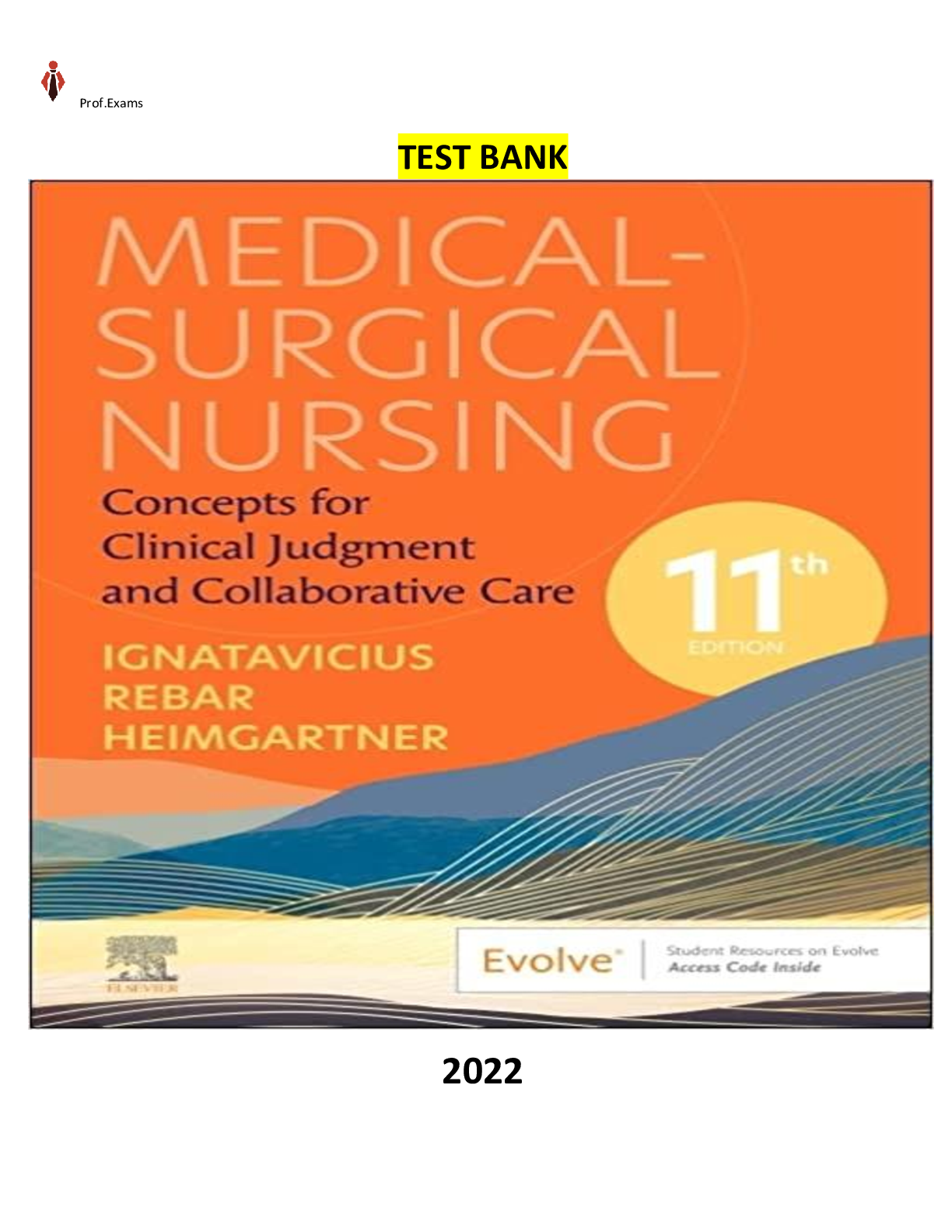
COMPLETE - Elaborated Test bank for Medical-Surgical Nursing - Concepts for Clinical Judgment and Collaborative Care 11ED.by Donna D. Ignatavicius , Cherie R. Rebar , Nicole M. Heimgartner
COMPLETE - Elaborated Test bank for Medical-Surgical Nursing - Concepts for Clinical Judgment and Collaborative Care 11ED.by Donna D. Ignatavicius , Cherie R. Rebar , Nicole M. Heimgartner COMPLETE -...
By Prof.Exams , Uploaded: Apr 01, 2023
$32.5
Business> TEST BANK > Test Bank For Introduction to Federal Income Taxation in Canada 43rd Edition (2022-2023) By Nathalie Johnstone , Devan Mescall , Julie Robson (All)
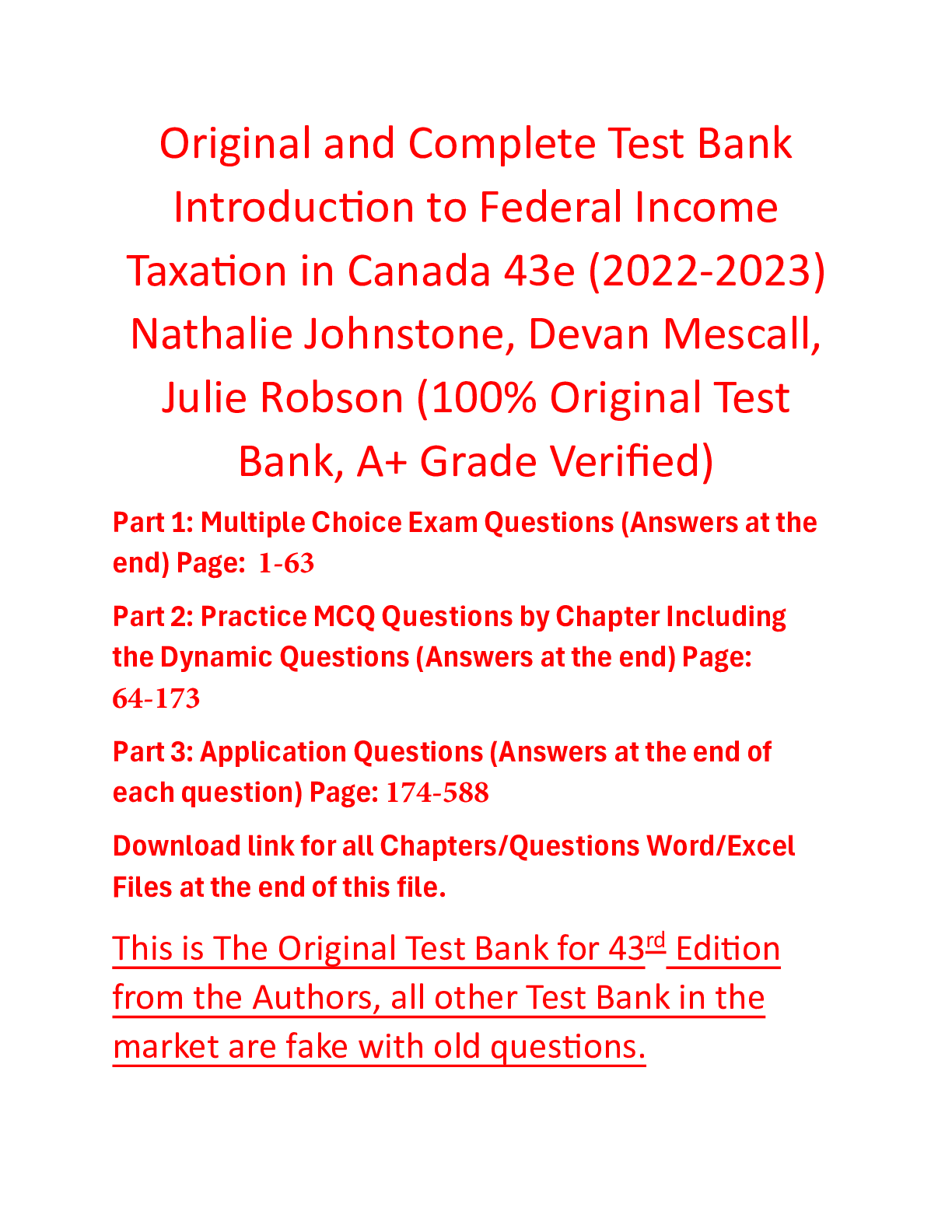
Test Bank For Introduction to Federal Income Taxation in Canada 43rd Edition (2022-2023) By Nathalie Johnstone , Devan Mescall , Julie Robson
This is Original 43rd Edition of Test Bank From Original Author. All Other Files in the market are fake/old Edition. Other Sellers Have changed old Edition Number to new But Test Bank is old Edition....
By eBookSmTb , Uploaded: Apr 01, 2024
$25
*NURSING> TEST BANK > TEST BANK for Understanding the Essentials of Critical Care Nursing 3rd Edition by Perrin. All 18 Chapters. (All)

TEST BANK for Understanding the Essentials of Critical Care Nursing 3rd Edition by Perrin. All 18 Chapters.
HERE IS A LIST OF THE CHAPTERS/CONTENT Chapter 1 What Is Critical Care? 1) Identify who of the Page : 22 Chapter 2 Care of the Critically Ill Patient 1) ʺResiliencyʺ Page : 56 Chapter 3 Care of...
By TESTBANKS , Uploaded: Nov 18, 2021
$19
*NURSING> TEST BANK > Test Bank For Priorities in Critical Care Nursing 9th Edition By Linda Urden, Kathleen Stacy, Mary Lough (All)
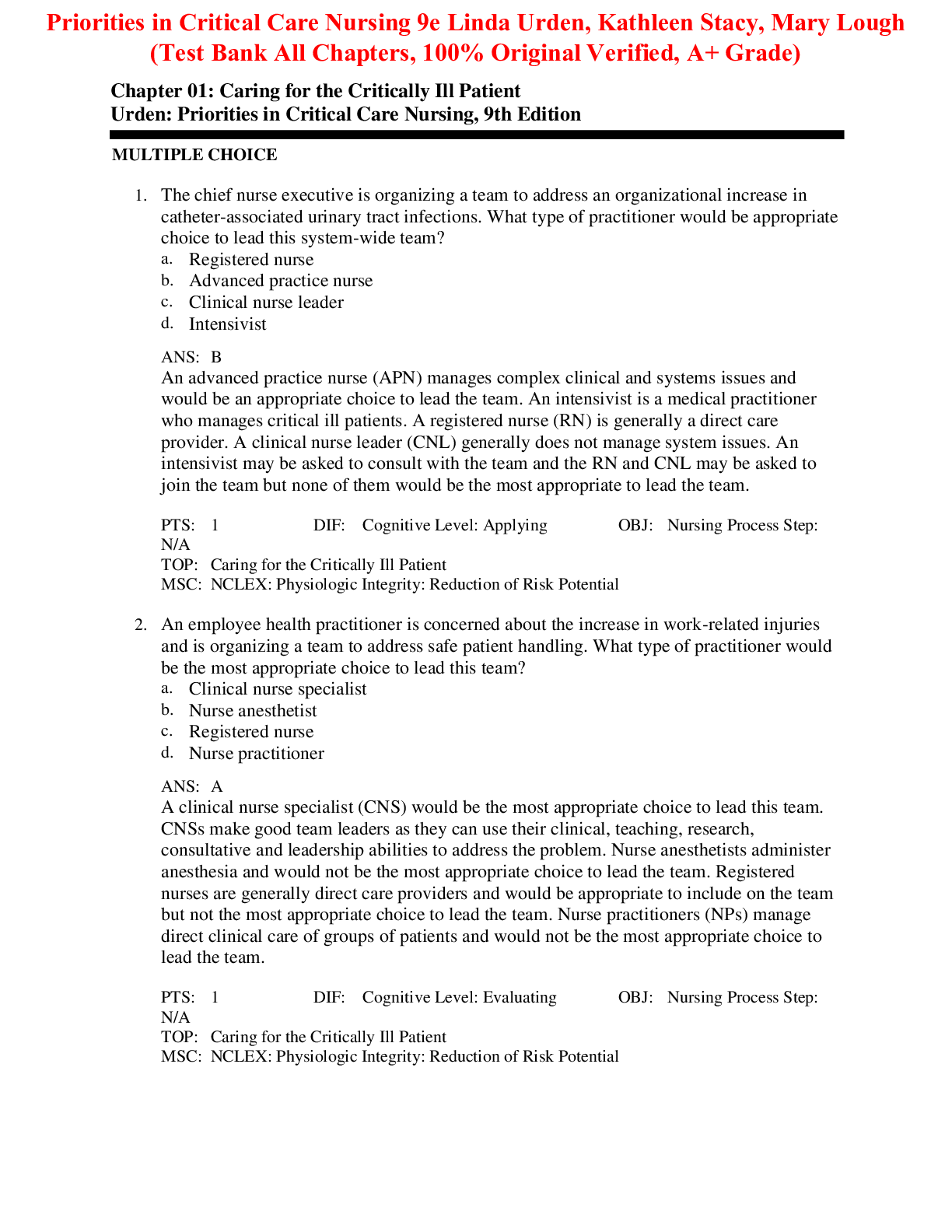
Test Bank For Priorities in Critical Care Nursing 9th Edition By Linda Urden, Kathleen Stacy, Mary Lough
This is Original 9th Edition of Test Bank From Original Author. All Other Files in the market are fake/old Edition. Other Sellers Have changed old Edition Number to new But Test Bank is old Edition....
By eBookSmTb , Uploaded: Mar 27, 2024
$13
Accounting> TEST BANK > Test Bank for Introduction to Federal Income Taxation in Canada 44th Edition By Nathalie Johnstone, Devan Mescall, Julie Robson (All Chapters, 100% Original Verified, A+ Grade) (All)

Test Bank for Introduction to Federal Income Taxation in Canada 44th Edition By Nathalie Johnstone, Devan Mescall, Julie Robson (All Chapters, 100% Original Verified, A+ Grade)
Test Bank for Introduction to Federal Income Taxation in Canada 44th Edition By Nathalie Johnstone, Devan Mescall, Julie Robson (All Chapters, 100% Original Verified, A+ Grade) Test Bank for Introduc...
By eBookSmTb , Uploaded: Mar 25, 2024
$15
*NURSING> TEST BANK > TEST BANK for Introduction to Critical Care Nursing 7th Edition by Sole. All Chapters 1 to 21. (All)
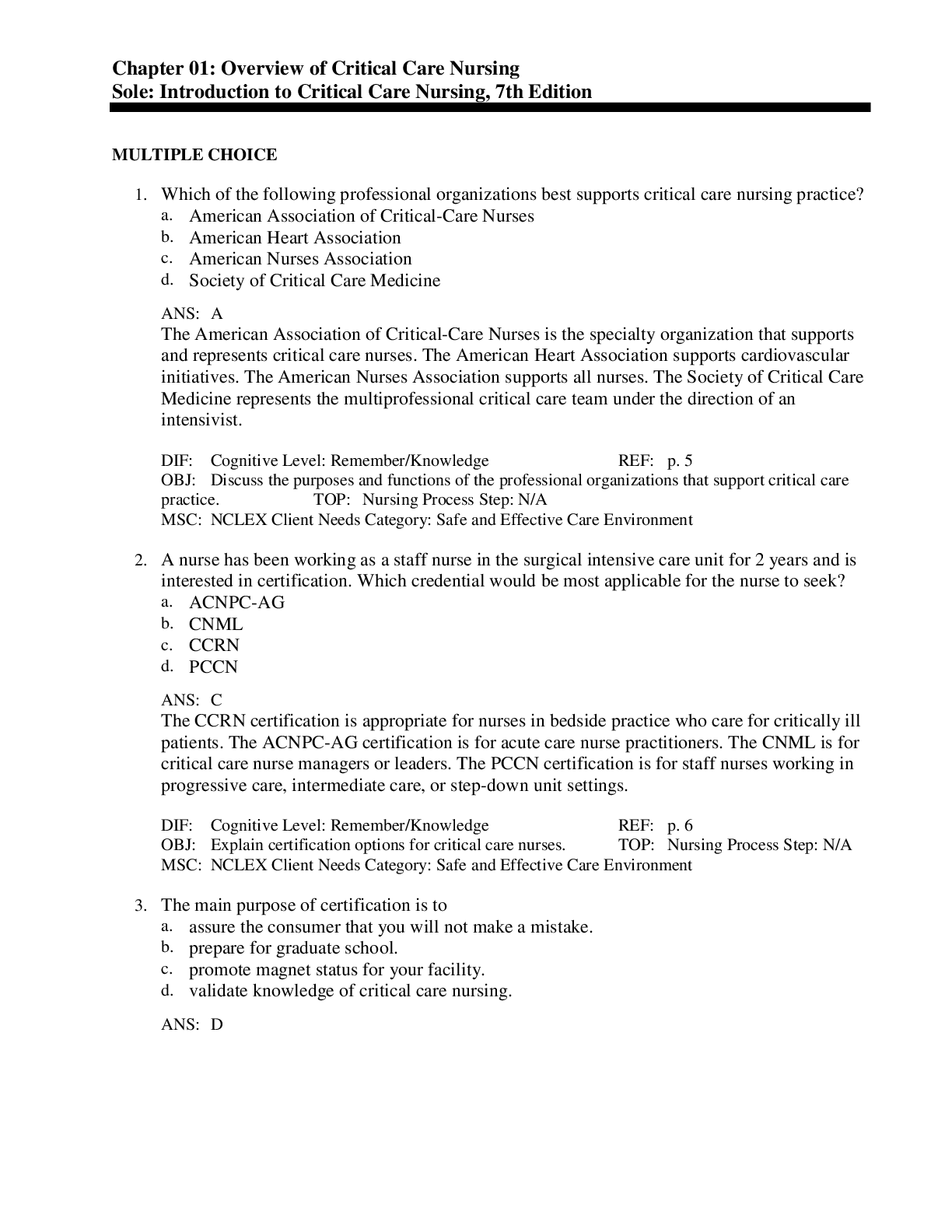
TEST BANK for Introduction to Critical Care Nursing 7th Edition by Sole. All Chapters 1 to 21.
Chapter 01: Overview of Critical Care Nursing Chapter 02: Patient and Family Response to the Critical Care Experience Chapter 03: Ethical and Legal Issues in Critical Care Nursing Chapter 04: End-...
By Kirsch , Uploaded: May 23, 2020
$17
*NURSING> TEST BANK > Test Bank for Introduction to Epidemiology 8 Edition Merrill All Chapters (All)

Test Bank for Introduction to Epidemiology 8 Edition Merrill All Chapters
Test Bank for Introduction to Epidemiology 8 Edition Merrill All Chapters Test Bank for Introduction to Epidemiology 8 Edition Merrill All Chapters Test Bank for Introduction to Epidemiology 8 Edition...
By Gradexam , Uploaded: Mar 07, 2024
$20
*NURSING> TEST BANK > Test Bank for Introduction to Sociology 2nd Edition Griffiths All Chapters (All)

Test Bank for Introduction to Sociology 2nd Edition Griffiths All Chapters
Test Bank for Introduction to Sociology 2nd Edition Griffiths All Chapters Test Bank for Introduction to Sociology 2nd Edition Griffiths All Chapters Test Bank for Introduction to Sociology 2nd Editio...
By Gradexam , Uploaded: Mar 07, 2024
$20
*NURSING> TEST BANK > Test Bank for Introduction to Learning and Behavior 5th Edition Powell All Chapters (All)
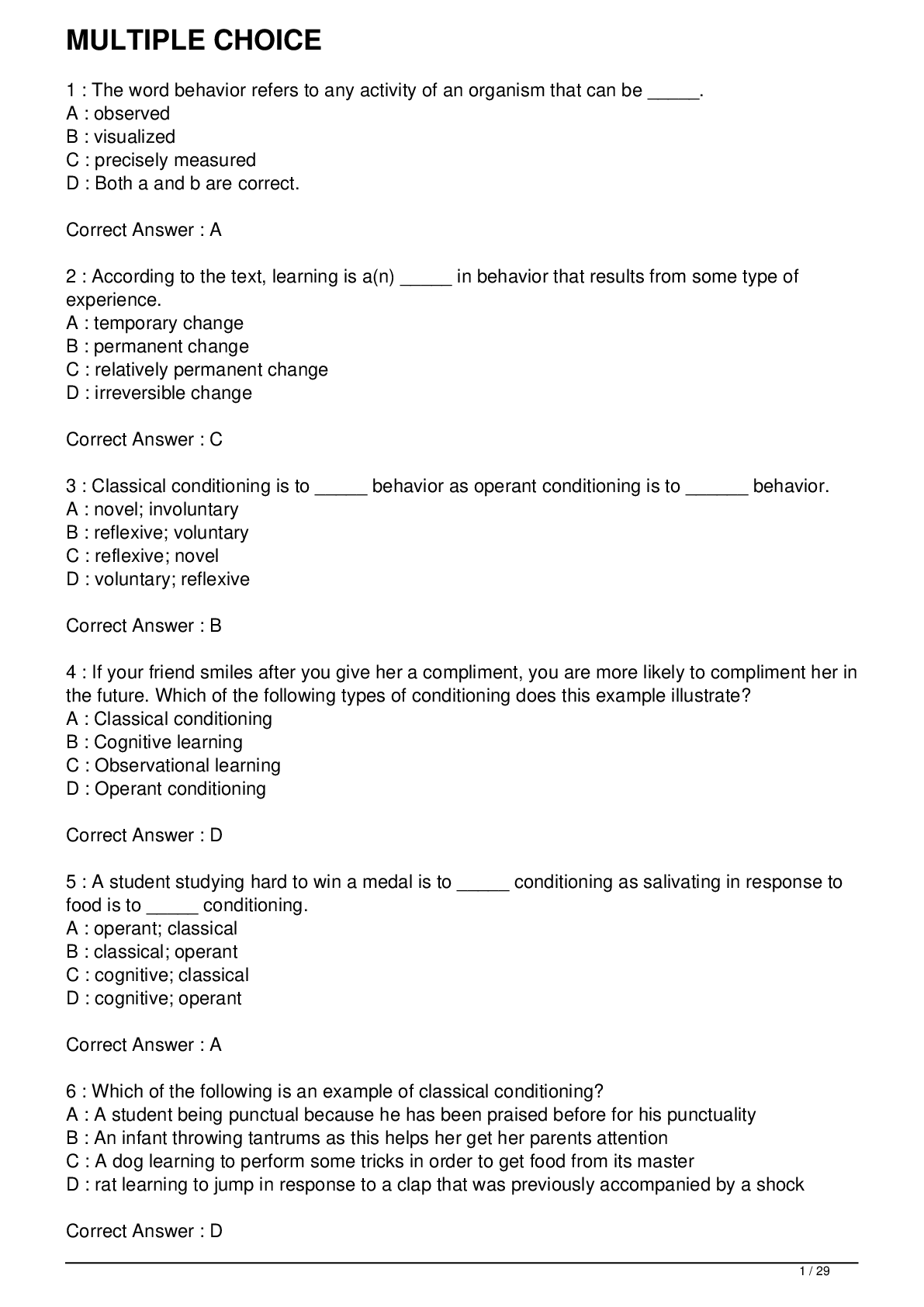
Test Bank for Introduction to Learning and Behavior 5th Edition Powell All Chapters
Test Bank for Introduction to Learning and Behavior 5th Edition Powell All Chapters Test Bank for Introduction to Learning and Behavior 5th Edition Powell All Chapters Test Bank for Introduction to Le...
By Gradexam , Uploaded: Mar 07, 2024
$20
*NURSING> TEST BANK > Test Bank for Priorities in Critical Care Nursing 9th Edition Urden All Chapters (All)

Test Bank for Priorities in Critical Care Nursing 9th Edition Urden All Chapters
Test Bank for Priorities in Critical Care Nursing 9th Edition Urden All ChaptersTest Bank for Priorities in Critical Care Nursing 9th Edition Urden All ChaptersTest Bank for Priorities in Critical Car...
By Gradexam , Uploaded: Mar 09, 2024
$20
Document information
Connected school, study & course
About the document
Uploaded On
Mar 25, 2023
Number of pages
346
Written in
Additional information
This document has been written for:
Uploaded
Mar 25, 2023
Downloads
0
Views
50






